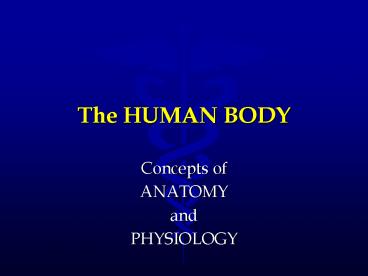The HUMAN BODY - PowerPoint PPT Presentation
1 / 51
Title:
The HUMAN BODY
Description:
Concepts of ANATOMY and PHYSIOLOGY ANATOMY The scientific study of structures and the relationship of structures to each other. FORM Other terms include shape ... – PowerPoint PPT presentation
Number of Views:113
Avg rating:3.0/5.0
Title: The HUMAN BODY
1
The HUMAN BODY
- Concepts of
- ANATOMY
- and
- PHYSIOLOGY
2
ANATOMY
- The scientific study of structures and the
relationship of structures to each other. - FORM
- Other terms include shape, structure, and
appearance.
3
PHYSIOLOGY
- The scientific study of the functioning of
specific body parts and systems. - FUNCTION
4
Levels of Organization
- Chemical Level
- Cellular Level
- Tissue Level
- Organ Level
- System Level
- Organism Level
5
Levels of Organization
6
Chemical Level
- All chemical substances essential for maintaining
life atoms-compounds-molecules. - Major Elements
- C - carbon
- H - hydrogen
- O - oxygen
- N - nitrogen
7
Cellular Level
- The cell is the basic unit of structure and
function. - Each cell has a unique structure and function.
- Muscle cells
- Nerve cells
- Blood cells
- Cartilage cells
8
Tissue Level
- Collection of similar cells grouped together to
perform a specific function. - Usually derived from a common embryonic origin.
- Four Major Tissue Types
- Epithelial Tissue
- Connective Tissue
- Nervous Tissue
- Muscular Tissue
9
Organ Level
- Structures composed of two or more different
tissues. - Have specific functions.
- Usually have recognizable shapes
- Heart
- Brain
- Kidney
- Liver
10
System Level
- An association of organs that have a common
function. - Digestive System
- Cardiovascular System
- Nervous System
- Lymphatic System
11
Organism Level
- All body systems are functioning with one another
as a living individual.
12
Metabolism
- The sum total of all chemical processes that
occur in the body.
13
Anabolism
- Using energy to synthesize or manufacture new
tissue or molecules.
14
Catabolism
- The breakdown of tissues or chemical structures
to produce or generate energy.
15
Position Descriptors
- Superior (Cranial)
- Inferior (Caudal)
- Anterior (Ventral)
- Posterior (Dorsal)
- Medial
- Lateral
- Proximal
- Distal
16
Position Descriptors
17
Anatomical Terms
18
Movement Descriptors
- flexion
- extension
- hyperextension
- abduction
- adduction
- plantar flexion
- dorsiflexion
- circumduction
- supination (LR)
- pronation (MR)
- inversion
- eversion
- elevation
- depression
- protraction
- retraction
19
Planes
- Fixed lines of reference along which the body or
organ is often divided to facilitate viewing.
20
Body Planes
21
Sagittal Plane
- A vertical plane which divides the body or
structure into right and left sections.
22
Sagittal Section of Thorax
23
MRI of Brain
24
Mid-Sagittal Plane
- A vertical plane which divides a body or
structure into equal right and left halves.
25
Frontal (Coronal) Plane
- A vertical plane which divides a body or
structure into anterior and posterior sections
26
X-Ray Frontal View
27
Transverse (Horizontal) Plane
- A horizontal plane which divides a body or
structure into superior and inferior sections.
28
Transverse Plane(Cross Section)
29
Chest CT Scan
30
Brain MRI
31
Planes - Overview
32
BODY CAVITIES
- Spaces within the body that contain the internal
organs.
33
Dorsal Body Cavity
- Cranial Cavity
- Contains the brain
- Spinal (Vertebral) Cavity
- Bony cavity formed by the vertebrae of the spine
that contains and protects the spinal cord.
34
Ventral Body Cavity
- Thoracic Cavity
- Pleural cavities (2)
- Mediastinum
- Pericardial cavity
- Abdominopelvic Cavity
- Abdominal cavity
- Pelvic cavity
35
Body Cavities
36
Abdominopelvic Quadrants
- The abdominopelvic cavity can be functionally
divided into quadrants. - Used by clinical personnel to describe the
location of abdominopelvic pain, tumors, and
other abnormalities.
37
Abdominopelvic Quadrants
- Used mostly in the medical and clinical
disciplines. - Functionally divides the abdominopelvic cavity
into four quadrants - RUQ - Right Upper Quadrant
- LUQ - Left Upper Quadrant
- RLQ - Right Lower Quadrant
- LLQ - Left Lower Quadrant
38
Quadrants and Organs
- RUQ liver, gallbladder, right kidney
- LUQ stomach, spleen, pancreas, left kidney
- RLQ appendix, right ovary
- LLQ left ovary
39
Abdominopelvic Quadrants
40
Homeostasis
- The ability of the body to maintain a constant
internal environment within prescribed
physiological limits.
41
Parameters Maintained in Homeostasis
- gas concentrations
- temperature
- pressure
- pH (acidity)
- nutrients
- water
42
STRESS
- Any factor which disrupts homeostasis.
- Any stimulus which creates an imbalance in the
bodys internal environment - Anything that causes stress - Stressor
- Physical
- Emotional
- Metabolic
- Environmental
43
External Stressors
- Heat
- Cold
- Noise
- Light
- Exercise
44
Internal Stressors
- Pain
- Tumors
- High blood pressure
- Chemical imbalances
- Unpleasant thoughts
45
Feedback Mechanisms
- Any circular situation in which information about
something is monitored and sent to a control
center
46
Components of a Feedback Mechanism
- Control Center
- An area that receives information about a
monitored condition and determines an appropriate
response. - Receptor
- An area or structure that monitors a controlled
condition. - Effector
- Structure that produces a response or changes a
controlled condition.
47
Feedback Mechanisms
48
Types of Feedback Mechanisms
- Negative Feedback Mechanisms (Inhibitory)
- The response counteracts the input.
- The most common feedback mechanism.
- Examples
- blood pressure
- blood sugar regulation
- cardiac output
- temperature regulation
- Positive Feedback Mechanisms (Stimulatory)
- The response is intensified by the input.
- Example Breastfeeding by an infant, childbirth,
and blood clotting.
49
Negative Feedback System
50
Positive Feedback System
51
(No Transcript)































